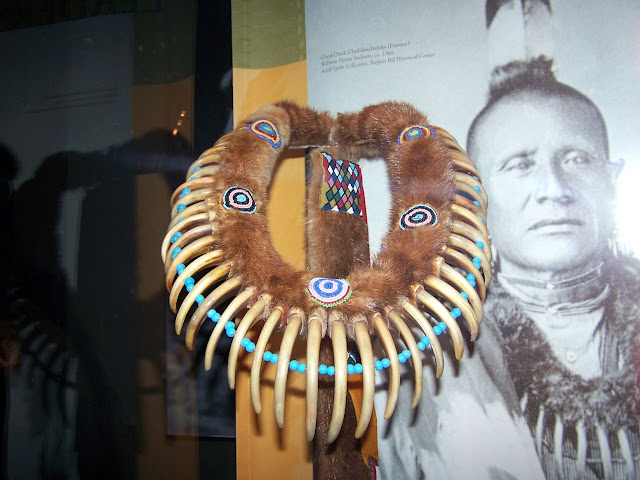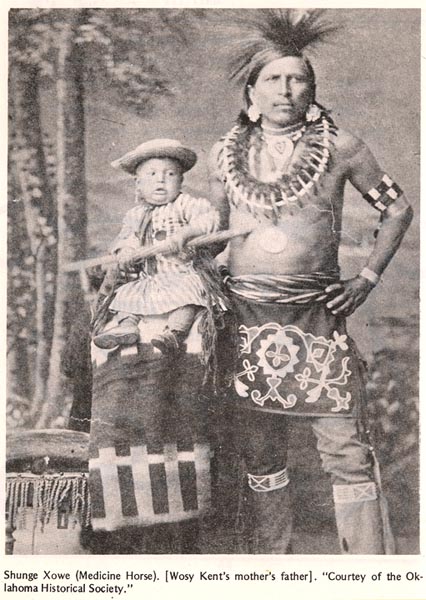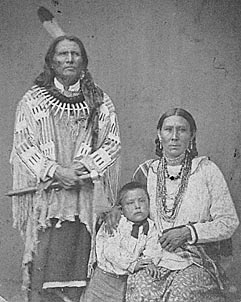Grizzly Bear Claw Necklaces
Apr 28, 2009 12:15:03 GMT -5
Red Indian Bear and wambli ahitunwan like this
Post by Historian on Apr 28, 2009 12:15:03 GMT -5
According to Norman Feder,
“...grizzly claw necklaces were apparently never vary numerous within any one tribe because of the difficulty in obtaining the claws.”
(Feder & Chandler, 1961, p. 7)
Even at a time when the great plains family of the grizzly bear species was abundant, it was difficult to hunt the animal. An early writer in the 1838 to 1840 period states,
“This famous grizzly bear is so ferocious that when the Osage wish to attack it, they raise a war party often fifty men strong”...“The victorious hunter is entitled to wear a necklace made with it’s claws.”
(Tixier, 1940, p. 248)
A common style of making the grizzly bear claw necklace among the Ponca, Osage, Iowa, Kaw, Omaha, Pawnee, Otoe and Missouri tribes has been described by Norman Feder as,
“...claws with double perforation, mounted on a core and covered with otter fur”...“a core that forms a continuous circle, and a tail composed of a separate otter skin pendant down the back.”
(Feder & Chandler, 1961, p. 11)
In addition, Thomas Mails makes reference to grizzly claw necklaces in “The Mystic Warriors of the Plains,” when he writes,
“The combined otter skin and bear claw necklaces”... “were made with broad bands of otter skin, and the long tail of the swift and cunning otter was arranged to hang down the center of the warrior’s back.”
(Mails, 1972, p. 372)
In most claw necklaces still in museum collections, there are an average of 40 claws in a necklace of this type, and usually only the longer front claws were used as the grizzly bear hind claws are much shorter. Large glass trade beads are often used as spacers between the claws, strung halfway down the claw at the secondary perforation alluded to above.
In latter years, with the depletion of the Great Plains Grizzly Bear (now extinct), many tribes made claw necklaces from Rocky Mountain Grizzly Bear, or from carved elk antler. In fact, as an example of how they became so popular, one of these grizzly claw necklaces made from carved elkhorn and collected at Fort Leavenworth, Kansas as early as 1838, is on display at the American Museum of Natural History.
Historically among the Ponca, as an example, it was usually notable warriors who gained the honor and right to wear a Grizzly Bear Claw Necklace. Either by killing two or more Grizzly Bears and making a necklace of the claws, or by killing an enemy warrior who wore a Grizzly Bear Claw Necklace, thus giving you the right to wear his. (Abe Conklin, 1986)
While seen occasionally among straight dancers today, the Grizzly Bear Claw Necklace may not have the same meaning associated with it's use back in the day.
Some examples:
A Mandan style Grizzly Bear Claw necklace. - circa 1834
{Note: A complete Otter hide covers the claws. This may have been an earlier style which lead to the more elaborate styles shown below.}

A Sauk & Fox style Grizzly Bear Claw necklace - circa 1860.
{Note: Strips of Otter fur covers the claws. The attached tail worn down the back, is made from a second Otter hide, including the tail.}

Another Sauk & Fox style Grizzly Bear Claw necklace
pro.corbis.com/images/WF003247.jpg?size=67&uid=%7B24D2122D-1CFA-4226-801F-41D6476F1A48%7D

Grizzly Claw Necklace of the Iowa Chief called The White Cloud, displayed by the Iowa tribe of Kansas and Nebraska in their museum.

The White Cloud painted by George Catlin in 1845

Sauk & Fox - 1860 (Courtesy of the National Museum of the American Indian)

More examples:
Brave Chief - Pawnee - 1858

Pipe Chief - Pawnee - 1858

Man Chief - Pawnee - 1858

The Chief Whom They Look Upon - Pawnee - no date

L-R: Sun Chief, A Fine Horse, Lone Chief, Struck By A Tomahawk, One Aimed At - Pawnee - 1868

Brave Chief - Pawnee - no date

Boss Sun (aka Sun Chief) - Pawnee - 1884

George Kit-kah-hak with son, William Pollock - Pawnee - no date

Roaming Chief - Pawnee - 1902

*******
Medicine Horse - Otoe - 1869

Little Pipe - Otoe - 1869

Crawfish Maker - Otoe - 1880

Far Away - Otoe - 1884

Standing Eating - Otoe - 1884

Makes A Noise - Otoe - 1884

Big Black Bear - Otoe - 1884

Robert Headman - Otoe - 1898

William Faw Faw - Otoe - no date

Brother of John Pipestem with wife - Otoe - 1906

Red Bear - Otoe - 1908

*******
Medicine Horse – Iowa – no date

Victor Dupee – Iowa – 1900

Blue Hair – Iowa – 1900

*******
Standing Hawk, Little Chief, Rattling Thunder - Omaha - 1866

The Chief - Omaha - 1869

The Chief - Omaha - no date

Pa-de-gi-he - Omaha - no date

Shon-ga-skah - Omaha - no date

Standing Bear - Omaha - no date

*******
Keokuk - Sauk & Fox - 1847

Rising Fish - Sauk & Fox - 1858

The Grey Fox - Sauk & Fox - 1858

Sauk & Fox men – 1866

Wah-Com-Mo - Sauk & Fox - 1868

Fish Floating To The Shore - Sauk & Fox - 1868

Many Scalps - Sauk & Fox - 1868

Moses Keokuk - Sauk & Fox - 1868

Cannot Do It - Sauk & Fox - 1890

Cannot Do It - Sauk & Fox - 1890

Shining River - Sauk & Fox - 1890

Shining River - Sauk & Fox - 1890

Winding Stream - Sauk & Fox - 1890

Po-Ga-Ha-Ma-We - Sauk & Fox - 1896

Po-ga-ha-ma-we - Sauk & Fox - 1896

Fish Rub Against Something - Sauk & Fox - 1896

Fish Rub Against Something - Sauk & Fox - 1896

Push-E-To-Neke-Qua and Joe Tyson - Sauk & Fox - 1899

*******
Standing Bear with wife and child - Ponca - 1877

Standing L-R: John Baptiste Barnaby, (Interpreter) - Otoe/Pawnee; Charles LeClaire, (Interpreter) - Ponca/French Canadian
Sitting L-R: Big Elk, Standing Buffalo Bull, White Eagle, Standing Bear - Ponca - 1877

Standing L-R: Big Snake, John Baptiste Barnaby (Otoe/Pawnee), White Eagle, Charles LeClaire (Ponca/French Canadian), The Chief
Sitting L-R: Black Crow, Big Elk, Standing Bear, Standing Buffalo Bull, White Swan, aka Frank LaFlesche, Sr.(Ponca/French Canadian), Smoke Maker
Reclining: Hairy Grizzly Bear - Ponca - 1877

White Eagle, Standing Bear - Ponca - no date

Little Eagle – Ponca – circa 1880

Standing Bear - Ponca - 1881

Standing Bear - Ponca - 1881

*******
Pa-thin-non-pa-zhi – Osage – 1868

Osage man – 1868

Osage men – 1868

Black Dog – Osage – 1876

Black Dog, Not Afraid of Pawnees - Osage – 1877

Reaches The Sky – Osage – 1877

“...grizzly claw necklaces were apparently never vary numerous within any one tribe because of the difficulty in obtaining the claws.”
(Feder & Chandler, 1961, p. 7)
Even at a time when the great plains family of the grizzly bear species was abundant, it was difficult to hunt the animal. An early writer in the 1838 to 1840 period states,
“This famous grizzly bear is so ferocious that when the Osage wish to attack it, they raise a war party often fifty men strong”...“The victorious hunter is entitled to wear a necklace made with it’s claws.”
(Tixier, 1940, p. 248)
A common style of making the grizzly bear claw necklace among the Ponca, Osage, Iowa, Kaw, Omaha, Pawnee, Otoe and Missouri tribes has been described by Norman Feder as,
“...claws with double perforation, mounted on a core and covered with otter fur”...“a core that forms a continuous circle, and a tail composed of a separate otter skin pendant down the back.”
(Feder & Chandler, 1961, p. 11)
In addition, Thomas Mails makes reference to grizzly claw necklaces in “The Mystic Warriors of the Plains,” when he writes,
“The combined otter skin and bear claw necklaces”... “were made with broad bands of otter skin, and the long tail of the swift and cunning otter was arranged to hang down the center of the warrior’s back.”
(Mails, 1972, p. 372)
In most claw necklaces still in museum collections, there are an average of 40 claws in a necklace of this type, and usually only the longer front claws were used as the grizzly bear hind claws are much shorter. Large glass trade beads are often used as spacers between the claws, strung halfway down the claw at the secondary perforation alluded to above.
In latter years, with the depletion of the Great Plains Grizzly Bear (now extinct), many tribes made claw necklaces from Rocky Mountain Grizzly Bear, or from carved elk antler. In fact, as an example of how they became so popular, one of these grizzly claw necklaces made from carved elkhorn and collected at Fort Leavenworth, Kansas as early as 1838, is on display at the American Museum of Natural History.
Historically among the Ponca, as an example, it was usually notable warriors who gained the honor and right to wear a Grizzly Bear Claw Necklace. Either by killing two or more Grizzly Bears and making a necklace of the claws, or by killing an enemy warrior who wore a Grizzly Bear Claw Necklace, thus giving you the right to wear his. (Abe Conklin, 1986)
While seen occasionally among straight dancers today, the Grizzly Bear Claw Necklace may not have the same meaning associated with it's use back in the day.
Some examples:
A Mandan style Grizzly Bear Claw necklace. - circa 1834
{Note: A complete Otter hide covers the claws. This may have been an earlier style which lead to the more elaborate styles shown below.}

A Sauk & Fox style Grizzly Bear Claw necklace - circa 1860.
{Note: Strips of Otter fur covers the claws. The attached tail worn down the back, is made from a second Otter hide, including the tail.}

Another Sauk & Fox style Grizzly Bear Claw necklace
pro.corbis.com/images/WF003247.jpg?size=67&uid=%7B24D2122D-1CFA-4226-801F-41D6476F1A48%7D
Grizzly Claw Necklace of the Iowa Chief called The White Cloud, displayed by the Iowa tribe of Kansas and Nebraska in their museum.

The White Cloud painted by George Catlin in 1845

Sauk & Fox - 1860 (Courtesy of the National Museum of the American Indian)

More examples:
Brave Chief - Pawnee - 1858

Pipe Chief - Pawnee - 1858

Man Chief - Pawnee - 1858

The Chief Whom They Look Upon - Pawnee - no date

L-R: Sun Chief, A Fine Horse, Lone Chief, Struck By A Tomahawk, One Aimed At - Pawnee - 1868

Brave Chief - Pawnee - no date

Boss Sun (aka Sun Chief) - Pawnee - 1884

George Kit-kah-hak with son, William Pollock - Pawnee - no date

Roaming Chief - Pawnee - 1902

*******
Medicine Horse - Otoe - 1869

Little Pipe - Otoe - 1869

Crawfish Maker - Otoe - 1880

Far Away - Otoe - 1884

Standing Eating - Otoe - 1884

Makes A Noise - Otoe - 1884

Big Black Bear - Otoe - 1884

Robert Headman - Otoe - 1898

William Faw Faw - Otoe - no date

Brother of John Pipestem with wife - Otoe - 1906

Red Bear - Otoe - 1908

*******
Medicine Horse – Iowa – no date

Victor Dupee – Iowa – 1900

Blue Hair – Iowa – 1900

*******
Standing Hawk, Little Chief, Rattling Thunder - Omaha - 1866

The Chief - Omaha - 1869

The Chief - Omaha - no date

Pa-de-gi-he - Omaha - no date

Shon-ga-skah - Omaha - no date

Standing Bear - Omaha - no date

*******
Keokuk - Sauk & Fox - 1847

Rising Fish - Sauk & Fox - 1858

The Grey Fox - Sauk & Fox - 1858

Sauk & Fox men – 1866

Wah-Com-Mo - Sauk & Fox - 1868

Fish Floating To The Shore - Sauk & Fox - 1868

Many Scalps - Sauk & Fox - 1868

Moses Keokuk - Sauk & Fox - 1868

Cannot Do It - Sauk & Fox - 1890

Cannot Do It - Sauk & Fox - 1890

Shining River - Sauk & Fox - 1890

Shining River - Sauk & Fox - 1890

Winding Stream - Sauk & Fox - 1890

Po-Ga-Ha-Ma-We - Sauk & Fox - 1896

Po-ga-ha-ma-we - Sauk & Fox - 1896

Fish Rub Against Something - Sauk & Fox - 1896

Fish Rub Against Something - Sauk & Fox - 1896

Push-E-To-Neke-Qua and Joe Tyson - Sauk & Fox - 1899

*******
Standing Bear with wife and child - Ponca - 1877

Standing L-R: John Baptiste Barnaby, (Interpreter) - Otoe/Pawnee; Charles LeClaire, (Interpreter) - Ponca/French Canadian
Sitting L-R: Big Elk, Standing Buffalo Bull, White Eagle, Standing Bear - Ponca - 1877

Standing L-R: Big Snake, John Baptiste Barnaby (Otoe/Pawnee), White Eagle, Charles LeClaire (Ponca/French Canadian), The Chief
Sitting L-R: Black Crow, Big Elk, Standing Bear, Standing Buffalo Bull, White Swan, aka Frank LaFlesche, Sr.(Ponca/French Canadian), Smoke Maker
Reclining: Hairy Grizzly Bear - Ponca - 1877

White Eagle, Standing Bear - Ponca - no date

Little Eagle – Ponca – circa 1880

Standing Bear - Ponca - 1881

Standing Bear - Ponca - 1881

*******
Pa-thin-non-pa-zhi – Osage – 1868

Osage man – 1868

Osage men – 1868

Black Dog – Osage – 1876

Black Dog, Not Afraid of Pawnees - Osage – 1877

Reaches The Sky – Osage – 1877


